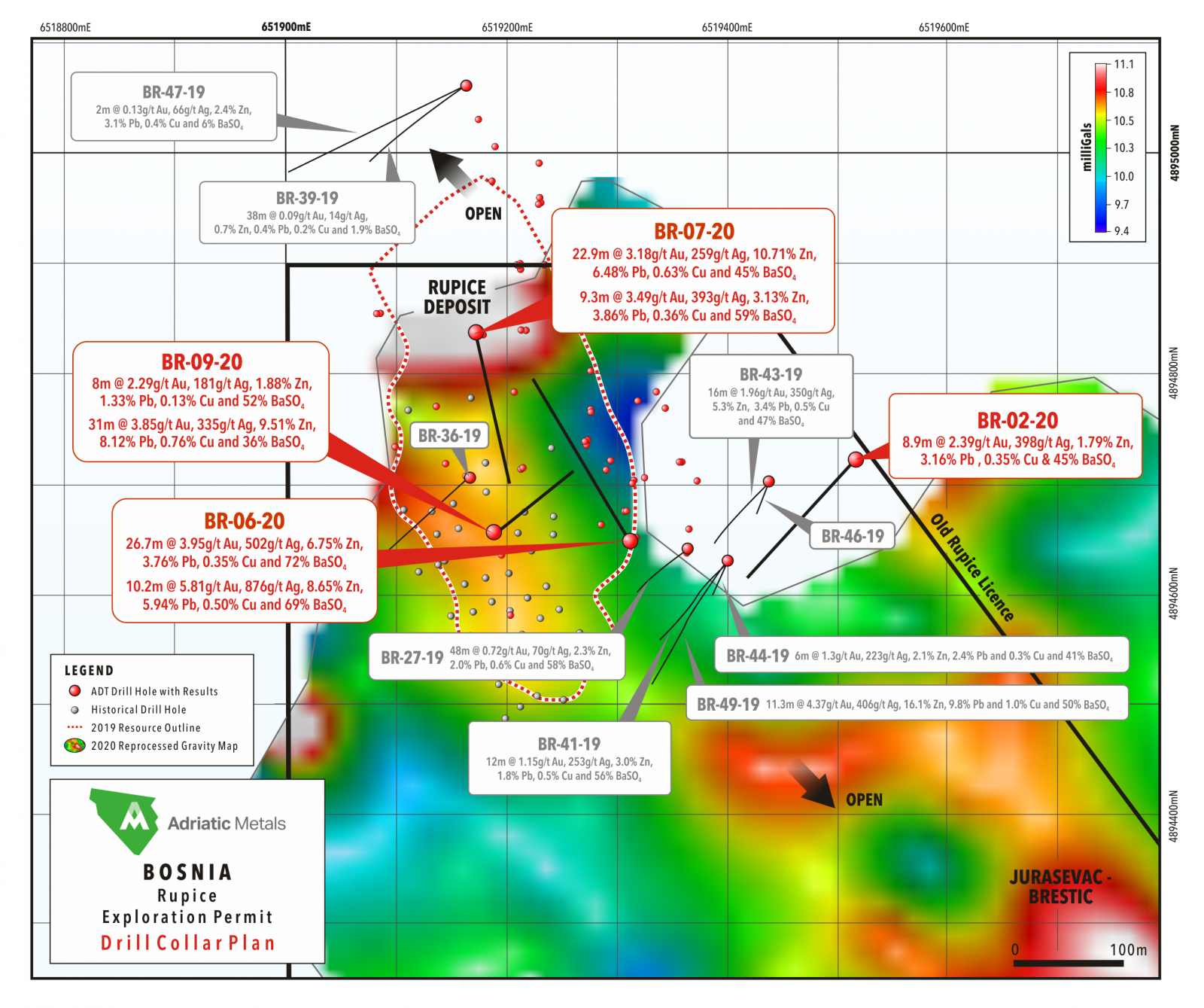Sulphide Mineralisation continues South and East at Rupice
Rupice Project
4 May 2020
BR-02-20 intersected massive sulphide mineralisation in the southeastern extension of the Rupice deposit, extending the known
mineralisation 20m down dip.
returning:
- 8.9m @ 2.40g/t Au, 398g/t Ag, 1.79% Zn, 3.16% Pb, 0.35% Cu and 45% BaSO4 from 368.5m.
This mineralised intersection in BR-02-20 is the deepest mineralised intersection drilled to date in the southern part of the Rupice deposit, and confirms continuity of mineralisation both down-dip and southward.
Drill results from infill drill holes BR-06-20, BR-07-20 and BR-09-20 confirm continuity of the high-grade mineralisation in the central part of the Rupice deposit:
- BR-06-20 – 26.7m @ 3.95g/t Au, 502g/t Ag, 6.75% Zn, 3.76% Pb, 0.35% Cu and 72% BaSO4 from 275.5m
- BR-06-20 – 10.2m @ 5.81g/t Au, 876g/t Ag, 8.65% Zn, 5.94% Pb, 0.50% Cu and 69% BaSO4 from 323m
- BR-07-20 – 9.3m @ 3.49g/t Au, 393g/t Ag, 3.13% Zn, 3.86% Pb, 0.36% Cu and 59% BaSO4 from 181.7m
- BR-07-20 – 22.9m @ 3.18g/t Au, 259g/t Ag, 10.71% Zn, 6.48% Pb, 0.63% Cu and 45% BaSO4 from 199m
- BR-09-20 – 31m @ 3.85g/t Au, 335g/t Ag, 9.50% Zn, 8.12% Pb, 0.76% Cu and 36% BaSO4 from 198m.

Drill hole BR-02-20 was drilled as part of the southern extensional drilling of the Rupice deposit. It is located 170 metres down-dip of drill hole BR-49-19, and 80 metres down-dip of BR-44-19, as reported 16 January 2020. BR-49-19 was the highest grade intercept drilled at Rupice to date. Mineralisation still remains open down-dip and to the south into previously untested ground outside of the current ore block model (Figure 2).
The mineralised intercept in BR-02-20 has confirmed mineralisation continues southward towards the Jurasevac-Brestic prospect. Drilling will continue to extend this known mineralisation both southward and down-dip.
Drill holes BR-06-20, BR-07-20 and BR-09-20 were drilled into the central part of the Rupice deposit in order to test the continuity of the known high-grade mineralisation. These drill holes were also designed to confirm the geological and structural model, and provide additional geotechnical information for the current pre-feasibility studies.
Along with structural geology specialist studies, and a revision of the geological controls on the mineralisation, new revisions to the structural and geological model have taken place.
The Rupice deposit is structurally complex, and the results from these infill drill holes have confirmed that there is good understanding of the geological and structural complexities of the deposit, with a good grade correlation to the existing neighbouring drill holes. This increased understanding will be utilised for future drill hole planning.
Drill hole BR-06-20 was drilled towards the northwest in order to intersect the massive sulphide mineralisation, perpendicular to the majority of the existing drilling, testing for any additional structural complications that may influence the controls on mineralisation. BR-06-20 intersected 2 confirmatory, robust zones of mineralisation, but was abandoned whilst drilling through the second zone due to drill rig issues (Figure 3).
BR-07-20 was also drilled perpendicular to the majority of the existing drilling, but was angled towards the south. Drill hole BR-07-20 also confirmed a wide zone of high grade mineralisation, returning a 23 metre intercept of robust mineralisation within the main massive sulphide orebody (Figure 4).
Drill hole BR-09-20 confirmed the high grade massive sulphide mineralisation, and structural offsets. BR-09-20 was drilled towards the northeast (Figure 5). The 2 mineralisation zones reported represent a structural repetition of the same ore zone due to a fault displacement.
To read the full press release, click here.

